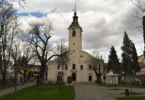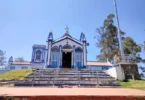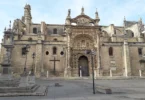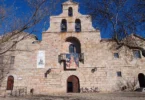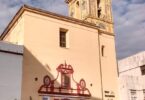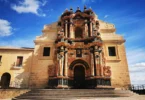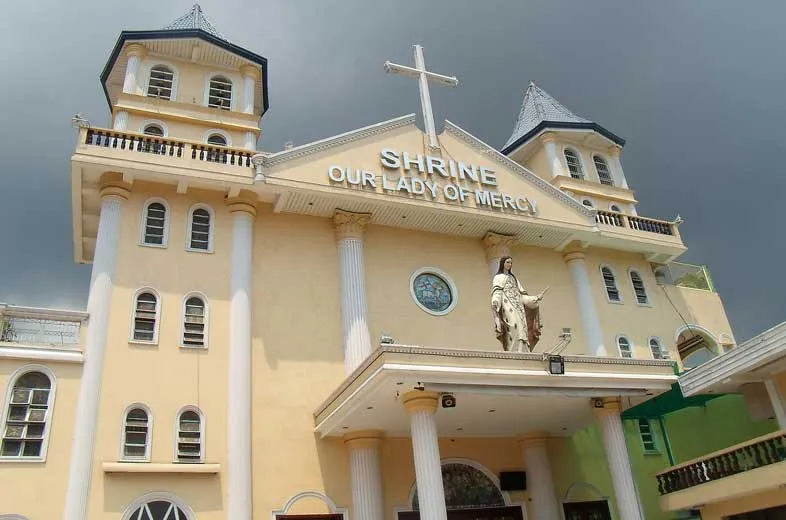
Introduction
The Diocesan Shrine and Parish of Our Lady of Mercy (Shrine of Our Lady Of Mercy Parish) (Filipino: Diyosesanong Dambana at Parokya ng Ina ng Awa; Spanish: Santuario Diocesano y Parroquia de Nuestra Señora de la Merced) is a Roman Catholic church under the Diocese of Novaliches. It is the oldest parish in the diocese, established in 1856 by the Augustinian missionaries from Spain.
This church was originally under the Archdiocese of Manila when it was established on September 24, 1856, by then Manila Archbishop José Julián de Aranguren. Since then, this parish had become an established landmark in the Novaliches area, witnessing the historical development of this district.
It is located along Quirino Highway, Barangay Sta. Monica, Novaliches, Quezon City. The current rector and parish priest is Rev. Fr. Jose Peregrino V. Tomas. The annual feast day of the church is September 24.
History of Shrine of Our Lady Of Mercy Parish
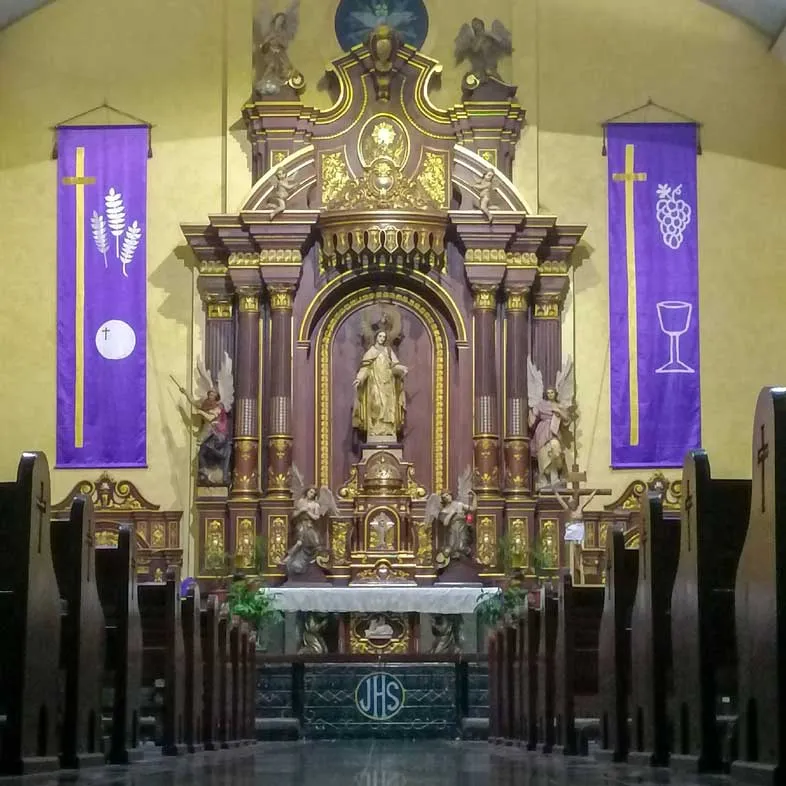
Shrine of Our Lady Of Mercy Parish – The establishment and history of Novaliches are linked to this church. After the Novaliches district was established in 1854, the first church was built two years later by the Augustinians under the decree of José Julián de Aranguren, Archbishop of Manila. On September 24, 1856, the church was established and was initially called the Chapel of Corpus Christi, dedicated to the Blessed Sacrament.
The chapel was elevated to the status of a Parroquia (parish church) and Fray André Martín, OSA was appointed as the first parish priest. It is said that he brought an image of Our Lady of Mercy holding the Child Jesus, similar to the iconography of the image of Nuestra Señora de la Consolación y Correa (Our Lady of Consolation and the Cincture) enshrined in San Agustín Church in Intramuros, Manila, and enshrined the said image in the parish.
The devotion to Our Lady of Mercy (Shrine of Our Lady Of Mercy Parish) developed over the years until the Philippine Revolution of 1896 against the Spanish Empire, when the original image disappeared. The church was burnt, and the assigned Augustinian priests returned to Spain. The sole relic of the old church saved from the Revolution is a golden chalice encrusted with amethysts. This was donated by Manuel Pavía y Lacy, First Marquis de Novaliches (1814-1896), who served as the Governor-General of the Philippines from 1852 to 1854.
The parcel of land where the church once stood was donated to the Archdiocese of Manila. In 1899, Novaliches was annexed to Caloocan. For about thirty years, nothing was heard about the Parroquia de Novaliches. In 1928, the parish was restored with the appointment of a diocesan parish priest, Rev. Fr. Victor Raymundo. The parish was renamed Our Lady of Ransom Parish, then later reverted to Our Lady of Mercy Parish. Under Rev. Fr. Segundo Alto in the 1950s, an image of Our Lady of Mercy, without the Child Jesus, emerged.
According to oral history, this image was first seen by Novaleños in the 1930s; it was actually commissioned by Macaria Sarmiento-Mendoza in the early 20th century and was identified to have been carved by Graciano Nepomuceno. This image was considered to be “La Verdadera”, being the oldest extant icon of Our Lady of Mercy in Novaliches, and was then enshrined at the high altar.
During the 1980s, the growing number of faithful residing in Novaliches prompted Rev. Msgr. Manuel Sebastián to renovate and expand the church. He also thought of commissioning a bigger replica of La Verdadera since it was too small. A de vestir (“in vestments”) replica carved by Rufino Rivera was completed in 1985 and enshrined in its own marble side altar. In the 1990s, the image was sacrilegiously toppled by an unknown individual, damaging it to the point it needed repairs. The image once again underwent restoration for a diocesan tour around Novaliches to propagate the devotion to Our Lady of Mercy. This second image is currently brought out for processions.
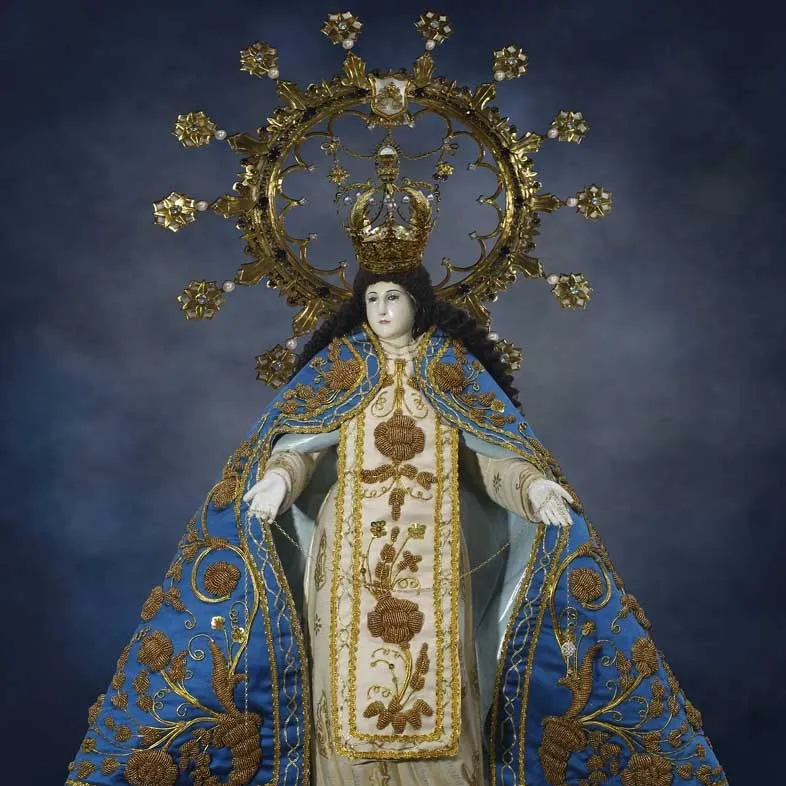
Renovation and Recognitions
In preparation for the elevation of the church (Shrine of Our Lady Of Mercy Parish) as a diocesan shrine, another major renovation began in 2001 through the initiative of Rev. Fr. Miguelito Lagrimas and the concerted efforts of the Novaleños and devotees of Our Lady of Mercy. The Susano family commissioned Wilfredo Layug to make a new altar with a new image of Our Lady of Mercy that is now seen today. The present image is bigger than life-size and this time, it deviated to the iconography of La Verdadera and the procession image. The new altar was consecrated on March 4, 2007.
Due to the enduring devotion to Nuestra Señora de la Merced in Novaliches and the historical importance of her sacred place, on September 15, 2008, the parish church was elevated as a diocesan shrine by Most Rev. Antonio R. Tobias, DD. On its first anniversary as a diocesan shrine, the church was presented with an 18-bell carillon, a token of gratitude from the devotees of Our Lady of Mercy. The 18-carillon bells were blessed on September 8, 2009, and installed in the church’s belfry.
Shrine of Our Lady Of Mercy Parish – Another historical milestone was granted to the diocesan shrine on January 1, 2021. Most Rev. Roberto O. Gaa, DD has declared Our Lady of Mercy as the second patroness of the diocese, and officially took the name “Ina ng Novaliches” (Mother of Novaliches). Tracing back the history, this church was the only parish in Novaliches, and from it sprung the different churches around the Novaliches district, including North Caloocan.
On April 09, 2021, Most Rev. Roberto O. Gaa, DD opened the Holy Door (Jubillee Door) of the shrine in celebration of the 500 years of Christianity in the Philippines. The shrine is one of the fourteen jubilee churches in the Diocese of Novaliches, in line with the said celebration.
Then on June 6, 2021, the Diocesan Shrine and Parish of Our Lady of Mercy of Novaliches formally obtained its Spiritual Bond of Affinity to Papal Basilica of Santa Maria Maggiore in Rome. The declaration was led by Most Rev. Charles John Brown, DD, Apostolic Nuncio to the Philippines, during a Corpus Christi Sunday Mass. This declaration would mean that habitual plenary indulgence and graces shall be granted among the faithful, with the same conditions.
And on September 24, 2021, its 165th anniversary as a parish, the Pontifical and Canonical Coronation Ceremony of Our Lady of Novaliches was held. The La Verdadera image received its pontifical crown and halo in a mass presided by Most Rev. Charles John Brown, DD, and concelebrated by Most Rev. Roberto O. Gaa, DD, Most Rev. Teodoro C. Bacani, Jr., DD, and Most Rev. Antonio R. Tobias, DD.
Virgin of Mercy (Our Lady of Mercy)
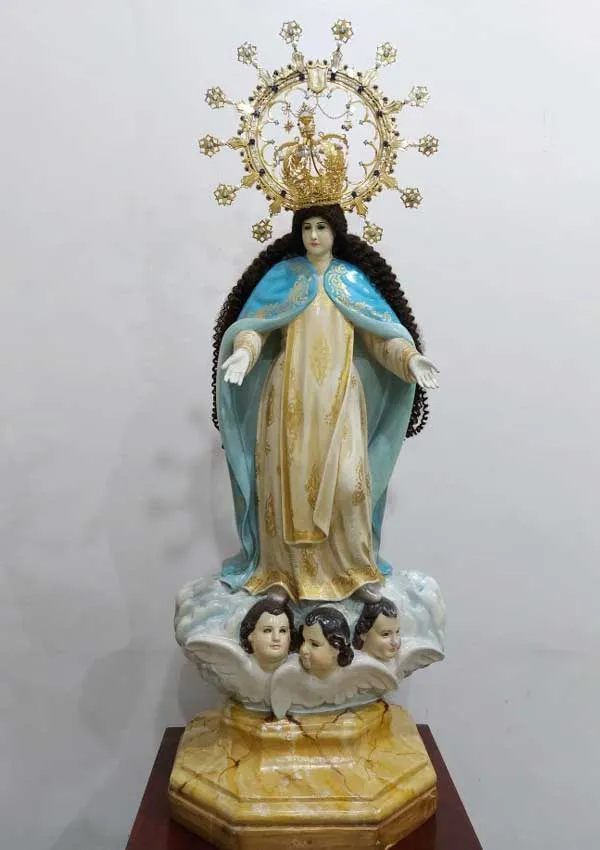
The Virgin of Mercy is a subject in Christian art, showing a group of people sheltering for protection under the outspread cloak, or pallium, of the Virgin Mary. It was especially popular in Italy from the 13th to 16th centuries, often as a specialised form of votive portrait, and is also found in other countries and later art, especially Catalonia and Latin America.
Usually the Virgin is standing alone, though if angels hold up the cloak, she is free to hold the infant Christ. She is typically about twice the size of the other figures. The people sheltered normally kneel, and are of necessity shown usually at a much smaller scale. These may represent all members of Christian society, with royal crowns, mitres and a papal tiara in the front rows, or represent the local population.
The subject was often commissioned by specific groups such as families, confraternities, guilds or convents or abbeys, and then the figures represent these specific groups, as shown by their dress, or by the 15th century individual portraits. Sometimes arrows rain down from above, which the cloak prevents from reaching the people.
Other Languages
In Italian it is known as the Madonna della Misericordia (Madonna of Mercy), in German as the Schutzmantelmadonna (Sheltering-cloak Madonna), in Spanish as the Virgen de la Merced or Nuestra Señora de la Misericordia (Virgin of Mercy), in French as the Notre-Dame de la Merci (Our Lady of Mercy), in Polish as the Matka Boża Miłosierdzia (Mother of God of Mercy), in Portuguese as the Nossa Senhora das Mercês, in Catalan as the Mare de Déu de la Mercè and in Greek as the Παναγιά του ἐλέους.
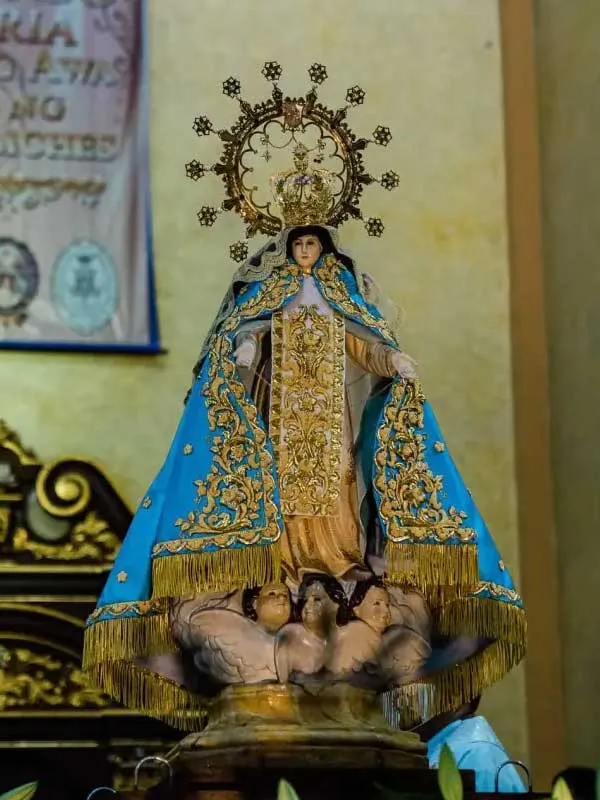
Pictorial Tradition In Christian Art
Probably the oldest version known is a small panel by Duccio of c. 1280, with three Franciscan friars under the cloak, in the Pinacoteca in Siena. Here the Virgin sits, only one side of the cloak is extended, and the Virgin holds her child on her knee with her other hand.
A miniature of c. 1274 from the Armenian Kingdom of Cilicia also shows a variant of the motif, as do 13th century paintings in Cyprus, such as an icon in the Byzantine Museum in the Archbishop’s Palace, Nicosia.
The common factor between all these is the influence and presence of Western mendicant orders, especially the Franciscans, who appear to have been important in spreading this form of iconography.
The immediate inspiration of the iconography comes from a vision reported in the Dialogus Miraculorum of the Cistercian Caesarius of Heisterbach which circulated widely from about 1230. Beyond that, the origins of the image may relate to rituals and a vision or miracle connected with a famous icon in the Blachernae Church in Constantinople.
This gave rise in the Byzantine Rite (Eastern Orthodox and Eastern Catholic Churches) to the Pokrov icons, although the image is not found in Byzantine art. In the Pokrov icons the thought is similar, but the image is usually less literal – the veil with which the Virgin protects mankind is small and held either in her hands or by two angels, though the Western version with a larger cloak is found in some Eastern Orthodox icons, one of a number of Western iconographic features that infiltrated Orthodox art, whether in Cyprus under the Crusaders or 16th-century Eastern Europe.
The image also fits well with the words of the ancient hymn Sub tuum praesidium, probably composed in the 3rd century, and used in most pre-Reformation churches of both the Western and Eastern churches.
Usually the image, whether in sculpture or painting, stands by itself. Nevertheless, in the most famous example, the Madonna della Misericordia altarpiece (1445–1462) in Sansepolcro by Piero della Francesca, the subject is the central panel of a large altarpiece, with a smaller Crucifixion above it, and many other panels.
The image came in for special derision from Martin Luther, who compared it to “a hen with her chicks”.
In the Spanish The Virgin of the Navigators of the 1530s, where those sheltered are a group connected with the Spanish voyages to the New World, including American indigenous peoples, the group is shown over a panorama of ships at rest in a harbour.
In Germany during the Middle Ages, an almost identical image was used featuring Saint Ursula, usually holding her attribute of an arrow to avoid confusion.
In this pictorial tradition, also the iconography of the Works of mercy alludes sometimes to the Virgin of Mercy, such as Caravaggio in his huge painting in Naples, because in 1606/07 it was commissioned for the church of the Confraternita del Pio Monte della Misericordia.
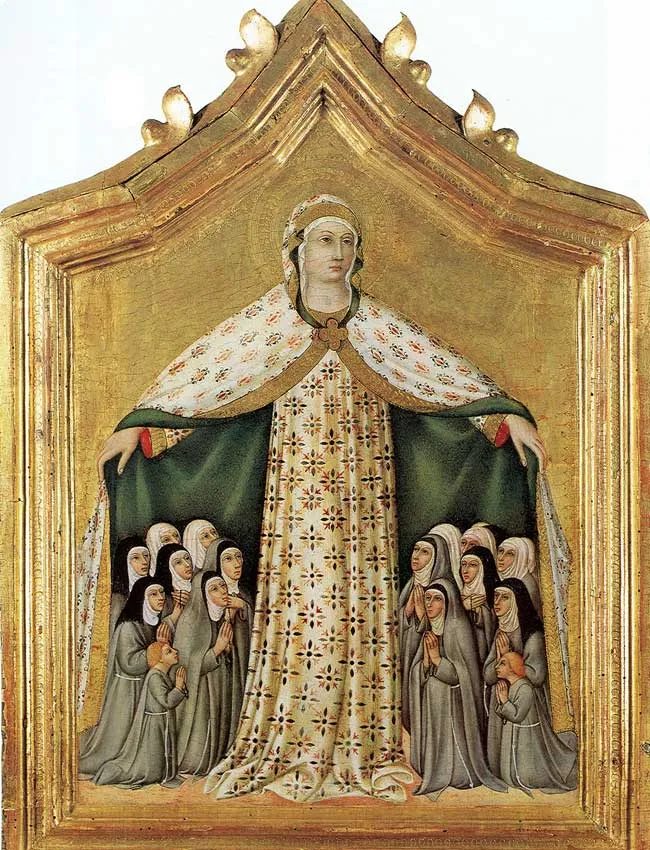
Veneration
One of the most famous shrines of the Virgin of Mercy is located in the Gate of Dawn in Vilnius, Lithuania. The Divine Mercy image and Divine Mercy Sunday were celebrated for the first time there thanks to the effort of Blessed Michał Sopoćko who fulfilled the wish of Jesus revealed to Faustina Kowalska.
Our Lady of Mercy is the co-patroness, along with St. Mark, of the Roman Catholic Diocese of Venice in Florida.
Churches dedicated to her include the cathedral of Guasdualito in Venezuela and the National Shrine of La Virgen de las Mercedes, also known as “El Santo Cerro” in La Vega, Dominican Republic.
Other Contexts
The term “Virgin of Mercy” is found in a number of other contexts not directly related to the image. It is a common translation of the Eleusa type of icon of the Virgin and Child.
The Virgin of Mercy is patron saint of Barcelona, celebrated in the week-long La Mercè festival each year, but in this role is not especially associated with this type of image. The Order of the Blessed Virgin Mary of Mercy, founded, also in Barcelona, in 1218 by Saint Peter Nolasco, has used the image but is not particularly associated with it.
In Santería, the Virgin of Mercy is syncretized with Obatala.
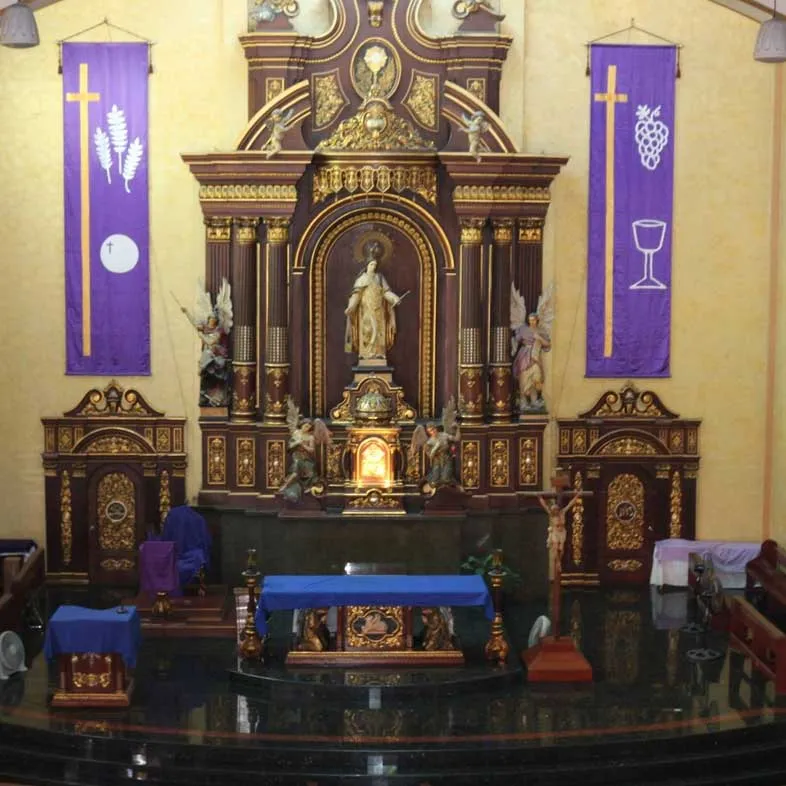
Images of the Our Lady of Mercy of Novaliches
There are three main images of Nuestra Señora de la Merced de Novaliches venerated in her shrine: the centuries-old original image, the processional de vestir image, and the now recognizable altar image.
"La Verdadera"
The original de tallado image presents the Blessed Virgin Mary as Our Lady of Mercy standing on a cloud with putti (little angels), both hands are raised and extended and previously holding a chain or the White Mercedarian Scapular, has long and wavy hair covered with a dainty veil wears a crown and the diagnostic doce estrellas. The original crown and halo were replaced with a 14-karat gold crown decorated with white pearls and diamonds and a gold-plated halo made of silver with pearls, diamonds and precious stones after the Pontifical and Canonical Coronation Ceremony.
The head of the Virgin is looking sideway which is quite interesting for this image. The Virgin wears a wig now, and the Mercedarian habit – the white habit and white scapular and a blue cape. The image is now securely enshrined on the side altar of the church after it received its pontifical and canonical crown and halo.
"De Vestir"
The second image is the de vestir processional image where it also shares the same elements of the original image of Nuestra Señora de la Merced de Novaliches from the vestments (richly embroidered white habit, white scapular, and blue cape), hands that are extended and raised holding the White Mercedarian Scapular and chain, wears a dainty veil and also wears a crown and the diagnostic doce estrellas. For this image, the Virgin faces the beholder with a sweet smile and wears a wig.
"Retablo"
The third and probably the currently recognized image of the shrine is the altar image. The current altar image is a more than life-size de tallado image that deviates from the traditional iconography of the first two images of the Shrine. For this image, the Virgin wears the Mercedarian habit from the white robe, cape and scapular hold the White Mercedarian Scapular on her right and a scepter on the left.
The Virgin looks sideways towards the left and has very modern Spanish features. The Virgin’s hair was long and wavy topped with a crown and the diagnostic doce estrellas. Most recently a smaller replica of the image was commissioned that would serve as a pilgrim image that would visit the communities within the vicinity of the shrine.
Feast Day – 24th September
The liturgical Feast Day of Our Lady of Mercy is celebrated annually in the General Roman Calendar on September 24.
Mass Time
Weekdays
- 6:00 am
- 6:00 pm
Sundays
- 6:00 am
- 7:00 am
- 8:00 am
- 9:00 am
- 10:00 am
- 12:00 (Noon)
- 4:00 pm
- 5:00 pm
- 6:00 pm
Contact Info
1102 Quirino Highway, Novaliches,
Quezon City, 1102 Metro Manila, Philippines.
Phone No.
Tel : +63 2 8939 2811
Accommodations
How to reach the Shrine
Manila Airport (MNL) also known as Ninoy Aquino International Airport in Philippines is the nearest Airport to the Shrine.
Quezon Avenue Metro Station is an elevated Manila Metro Rail Transit station located in Diliman in Quezon City is the nearby Train Station to the Shrine.


